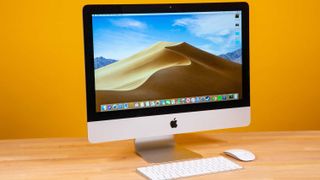iMac 2021 vs iMac 2019: What’s the difference?
Apple's got a totally new iMac, but should you wait to buy the new model?

Ever since Apple announced it was moving away from Intel processors in favor of Mac-designed hardware, we've been eagerly watching the rumors of new iMacs. For months we've heard whispers of new desktop designs that slim down the all-in-one and offer new colors, and yesterday we learned that the rumors were true.
But how does this new iMac 2021 with M1 processor stack up against the most recently updated 2019 iMacs using Intel processors?
- New Apple TV 4K vs old Apple TV 4K: What's the difference?
- Everything you need to know about iPad Pro 2021
With so many new details to sift through, it can be tough to figure out which you should buy, especially if that means waiting for the new iMacs to arrive in late May. Is one iMac better than the other? Is it worth waiting to buy the new iMac?
We've pulled together all of the details to help you decide.
iMac 2021 vs. iMac 2019: Specs compared
There are plenty of points of comparison between the old and new iMacs, thanks to the thorough re-imagining of the iMac that the new 2021 model gives us. Let's start with specs.

| Price | $1,299 | $1,499 | $1,699 |
| CPU | Apple M1 (8-Core) | Apple M1 (8-Core) | Apple M1 (8-Core) |
| RAM | 8GB (configurable to 16GB) | 8GB (configurable to 16GB) | 8GB (configurable to 16GB) |
| GPU | 7-core | 8-core | 8-core |
| Storage | 256GB SSD (configurable up to 2TB) | 256GB SSD (configurable up to 2TB) | 512GB SSD (configurable up to 2TB) |
| Display | 24-inch 4.5K Retina display | 24-inch 4.5K Retina display | 24-inch 4.5K Retina display |
| Webcam | 1080p FaceTime HD Camera | 1080p FaceTime HD Camera | 1080p FaceTime HD Camera |
| Colors | Green, pink, blue, and silver | Green, yellow, orange, pink, purple, blue, silver | Green, yellow, orange, pink, purple, blue, silver |
The Apple iMac 24-inch model is new for 2021, and is first Apple desktop to use the Apple M1 processor, another step in Apple's transition away from Intel silicon to chips of its own design.
But the differences don't stop there. The 2021 iMac may have some similarities with iMacs of old, but the new era of iMac is slimmer, sleeker and more colorful, with bigger displays, a revamped sound system, and much, much more.
Sign up to get the BEST of Tom’s Guide direct to your inbox.
Upgrade your life with a daily dose of the biggest tech news, lifestyle hacks and our curated analysis. Be the first to know about cutting-edge gadgets and the hottest deals.

| Price | $1,099 | $1,299 | Up to $3,349 |
| CPU | Intel Core i5 (dual-core, 7th Gen) | Intel Core i3 (quad-core, 8th Gen) | Intel Core i7 (six-core, 8th Gen) |
| RAM | 8GB | 8GB | Up to 32GB |
| GPU | Intel Iris Plus Graphics 640 | Radeon Pro 555X w/ 2GB VRAM | Radeon Pro 555X w/ 4GB VRAM |
| Storage | 256GB SSD | 256GB SSD | Up to 1TB Fusion Drive |
| Display | 21.5 inches, 4096 x 2304 | 21.5 inches, 4096 x 2304 | 21.5 inches, 4096 x 2304 |
| Webcam | 720p FaceTime camera | 720p FaceTime camera | 720p FaceTime camera |
| Colors | Silver | Silver | Silver |
The older 21.5-inch iMac from 2019, on the other hand, is still being sold, and offers a wider range of configurations and price points.
But while the older design of the iMac was iconic, it hadn't had a meaningful change since 2012.
iMac 2021 vs. iMac 2019: Price
If price is your biggest concern, then the older iMac's base configuration is the Mac desktop to choose, coming in $200 cheaper than the most affordable M1 iMac. But higher configurations climb higher in price, and the cost jumps by hundreds or even thousands of dollars at the top end. Those higher prices do correspond to better hardware options — including 4 and 6-core processors, significantly more RAM and different GPU options ranging from integrated graphics to a beefy AMD Radeon graphics card — but in its most powerful form, the iMac 2019 is not cheap.
While there will surely be more expensive configurations of the new iMac 2021 with M1, the currently announced pricing is pretty reasonable. Starting at $1,299 and scaling up to just $1,699 for the top configuration with 8-core graphics and 512GB SSD, it's all pretty affordable.
That said, the new iMac 2021's lowest price point does come with some compromises: fewer color options, a smaller port selection and less potent 7-core graphics.

iMac 2021 vs. iMac 2019: Design and colors
The new iMac is much, much slimmer than past models. In fact, the 11.5-millimeter chassis is slimmer than most standalone monitors, and it houses all of the iMac's components inside. The old iMac hump is gone, too, with a design that looks a heck of a lot more like an iPad on a stand than any other all-in-one computer we've seen.
The older 2019 iMac measures 20.8 x 17.7 x 6.9 inches, and while that was a pretty svelte machine when the design was introduced nine years ago, the 12 pound desktop was still pretty chunky by today's standards.
The new 2021 iMac leverages the M1-powered hardware for a sleeker design that measures 21.5 x 18.1 x 5.8 inches. It's a little taller and a little wider, but the difference in screen size is huge, and the 11.5-millimeter thick chassis looks fantastic. It's also shed some bulk, weighing in at just 9.9 pounds.

The new iMac design combines a sleek new approach to hardware with the candy shop color options of iMacs from the late '90s. The iMac G3 came in 13 colors (including the iconic Bondi Blue), and the new iMac has its own rainbow of options, with seven colors to choose from: green, yellow, orange, pink, purple, blue, silver.
The older iMacs followed the Henry Ford philosophy of color choices — any color you want, so long as it's silvery aluminum.
The newer iMac 2021 definitely has a lot of callbacks to the previous design, with visual elements like the chin below the screen, a single pedestal base and a stand that offers angle adjustment to tilt the screen back, but no height adjustment at all. So that stack of books you had your old iMac on might still come in handy with this new model.
iMac 2021 vs. iMac 2019: Display
The design of the iMac 2021 may be slimmer, but the display is actually larger, measuring 24-inches diagonally and surrounded with dramatically thin bezels. The larger display boasts a higher resolution (4480 x 2520), which Apple is calling 4.5K Retina. That's not only great news for anyone that enjoys streaming 4K videos and working in higher resolutions, it's also ideal for video editing, since it should let you work with 4K video at full resolution, while still having room for editing tools along the sides and bottom of the screen.
The 21.5-inch display of the iMac 2019, on the other hand, was stuck with 1920-by-1080 resolution on the cheapest model, although the step up model offered a more traditional 4K display with 4096-by-2304 resolution. Even with the higher-resolution screen, the older 4K iMac surrounded the display with thick bezels that have looked pretty dated for the last few years.
The newer iMac 2021 not only has better resolution by default, it also offers brightness up to 500 nits, better color with P3 wide color gamut, and True Tone automatic color adjustment that matches the color temperature to whatever looks best with the ambient light of your surroundings. And it has an anti-reflective coating to keep glare at bay.
iMac 2021 vs. iMac 2019: Performance
Equipped with the same Apple M1 processor we saw in our Apple Mac mini with M1 and MacBook Pro with M1 reviews, we can safely say that the performance on the new iMac should be excellent.

And Apple pairs the new hardware with its own software, starting with the macOS Big Sur operating system. Built from the ground up to make the most of Apple silicon hardware, you can get it on Intel-based Macs, but you'll see the best performance on Apple M1. Apple promises that the new iMac 2021 will outpace the older 2019 model with ease, offering snappier wake times and app launches, with 85% faster processor performance and graphics that are twice as quick as older Intel-based models. And from what we've seen in testing other M1-equipped Macs, those claims hold up. The new 24-inch iMac with M1 will likely be a huge improvement over the past generation.

Another great benefit of Apple silicon is that, thanks to the shared architecture with other Apple products, you can now run iPad and iPhone apps natively on the iMac. And with Apple's Continuity and iCloud features, you get a pretty seamless experience with your other Apple devices, letting you take calls and messages on the desktop, hand off drafts between the different machines and share a universal clipboard for easy text sharing.

iMac 2021 vs. iMac 2019: Ports
Apple has updated the port selection on the latest iMac, but it may not be a slam dunk. On the most basic model, the 2021 iMac has two dual Thunderbolt/USB 4 ports. While these will support all sorts of uses, including connecting external monitors and storage, it seems pretty limiting to only have two of them.
The two more expensive configurations of the new iMac add an additional pair of USB 3 ports, using USB-C connections. That's a total of 4 USB-C connections, but two very different connectivity standards.
What's missing from this collection of ports is anything other than USB-C and Thunderbolt. Unlike the 2019 iMac, the new 24-inch model has no HDMI port and no SD card slot. Nor are there any standard USB ports, so even your basic flash drives will need an adapter to be plugged in.

And it's a far cry from the rich collection of ports found on past iMacs. The 2019 iMac had four USB-A ports, as well as a pair of Thunderbolt 3/USB-C connections, an SDXC card slot and a headphone jack.
What's even more frustrating is that these ports can be found on another M1-powered desktop, the 2020 Mac mini — where an HDMI port and USB-A slots came standard. Which means that there's no hardware limitation to blame for removing these useful and common connectors, just Apple's proclivity toward new standards and a fondness for pricey adapters (which they conveniently sell).
Other quirky new connections on the 2021 iMac include an Ethernet port that's built into the power adapter, and a magnetic power cable connection that's like a MagSafe plug-in for your stationary desktop. I'm not sure how useful that magnetic power connector actually is, but it's at least something new that should add a little gee-whiz excitement when you're setting up your new iMac.

iMac 2021 vs. iMac 2019: Sound
The audio in the new iMac gets a huge upgrade from the previous models, replacing the stereo speakers of past models with a 6-speaker system. The new speaker setup has two pairs of woofers that not only deliver room-filling sound but that also use force cancelling to keep unwanted vibration to a minimum. These are matched with a high-performance tweeter that pairs the solid bass of the woofer with clear highs and mid-range sound.
And the whole thing is mounted along the bottom of the iMac with a downward firing orientation that reflects more sound back up, which Apple uses to create a larger soundstage. That broader, taller spatial audio also supports Dolby Atmos, which should deliver great sound for all of your entertainment and working needs.
iMac 2021 vs. iMac 2019: Webcam and microphone
The new iMac gets an upgraded webcam that bumps the resolution up from the 720p camera of the older iMac to a 1080p HD FaceTime camera. And it pairs this with built-in image processing that uses more than a half-dozen optimizations to make your camera image quality even better, with better clarity and color. The older 720p camera wasn't bad, but the better resolution and color of the 2021 iMac will make it the one to choose if you want to look your best in those work video calls.
A three-microphone array will also let you be heard more clearly, with beam-forming technology that captures more of your voice and less of the ambient noise around you.

iMac 2021 vs. iMac 2019: Connectivity
The older 2019 iMac used the connectivity standards of the day, with 802.11ac wireless networking and Bluetooth 4.2 for connecting various cordless peripherals. While that was a pretty good setup for the time, standards have since evolved.
The new iMac steps things up with Wi-Fi 6 and Bluetooth 5.0. It'll still be compatible with older routers and Bluetooth accessories, but if you want a system that offers the latest and best options for wireless connections, the iMac 2021 is the one to get.
Wired connectivity is also a little different on the new iMac. While both the old and new models have an Ethernet jack, the new 2021 iMac shifts the actual Ethernet port off of the desktop and onto the power adapter, putting a LAN port onto the brick, right next to the power cable, and running the wired connection through the braided magnetic power cable.
It's an interesting choice, and one that manages to be both useful and very in-line with Apple's idiosyncratic approach to design and external device support.

iMac 2021 vs. iMac 2019: Accessories
Speaking of external devices, the 2021 iMac gets a cool collection of accessories to choose from. In true Apple fashion, the new peripherals don't diverge dramatically from what was offered in the past, with a Magic Keyboard and Magic Mouse that would look identical to past models were it not for splashes of color that match the many color options of the new iMacs. But there's more to the new collection of "Magic" accessories than matching colors.
The new Magic Keyboard comes in three flavors. The basic model has been upgraded with function keys for emojis, spotlight, dictation and do not disturb keys. It also has a lock key. This one is the new standard keyboard that comes included with the most affordable iMac at no extra cost.
But the next model upgrades that lock key to include Touch ID, bringing fingerprint-based security to iMac for the first time. It's a very cool feature, but it only comes standard with the 8-core versions of the iMac.
Finally, there's a full-sized version of the Magic Keyboard with Touch ID that also has a numeric keypad and additional arrow and function buttons. You'll pay a little extra for this model, but it still offers that same functionality and color that matches your iMac.
Colorful new versions of the Magic Mouse and Magic Trackpad are also coming alongside the new iMac, but are largely unchanged. Unfortunately, that means that the Magic Mouse still has the same confusingly bad charging port on the bottom of the mouse, leaving you unable to use the mouse and power it up at the same time.
iMac 2021 vs. iMac 2019: Verdict
Unless you're a sucker for the older iMac design, or maybe need more ports than the new iMac offers (but refuse to buy a separate adapter or dock), there's almost no reason not to go for the newer Apple iMac 2021 with M1 processor over the older iMacs that are still being sold.
The newly announced 2021 iMac with M1 chip looks better, has more personality and gives you more overall capability than past iMac models, while still keeping you in the warm embrace of Apple's ecosystem. In fact, thanks to improved cross-compatibility with iPhone and iPad, there's never been a better desktop for the Apple faithful.
Brian Westover is currently Lead Analyst, PCs and Hardware at PCMag. Until recently, however, he was Senior Editor at Tom's Guide, where he led the site's TV coverage for several years, reviewing scores of sets and writing about everything from 8K to HDR to HDMI 2.1. He also put his computing knowledge to good use by reviewing many PCs and Mac devices, and also led our router and home networking coverage. Prior to joining Tom's Guide, he wrote for TopTenReviews and PCMag.
-
probitionate Four years ago, I waited for a new iMac. Only lasted two years. Spent the following two waiting for a proper refresh. Soooooooo disappointed with this model. Chin? Two ports on the entry-level? No space-grey/graphite colour? I'm actually having to seriously consider not re-investing. <<Edited for content by moderator>>Reply

